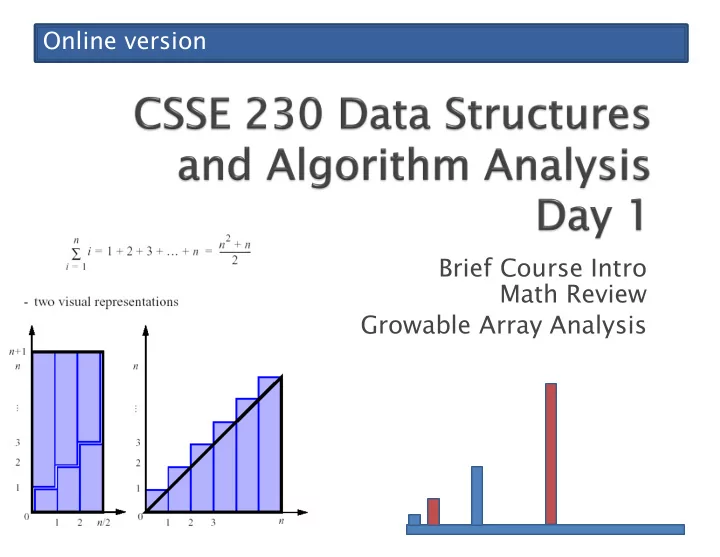

Online version Brief Course Intro Math Review Growable Array Analysis
An And intro to daily quizzes, worth 5% of grade: Q1 Matthew Boutell (Rhymes with Math, You Now Tell) Yes: CS & Math, teaching background Please introduce yourself to me and your classmates on the discussion forum, e.g., what are your passions, your favorite food, your hobbies, types of work you’ve done, etc. (5pts toward homework grade) I’ll do this too.
Yo You show Top Topic I I do Yo You do do Yo You pr practice off of Homework Tests Analysis sets Explain, Listen, follow, show, do read, quiz Major Tests, Programming programs project
Here’s $1,000,000,000: } Find serial number KB46279860I } If unsorted, you could look at all 10 million bills. } If sorted by serial number, binary search finds it by only looking at _____ bills. https://commons.wikimedia.org/wiki/File:Oenbilliondollar.jpg
Q2 Q2 } Take initiative in learning Search Javadocs, Google, textbook, come for help Re-do CSSE220 stuff as needed to make sure your foundations (recursion and linked lists) are strong } Focus while in this class ◦ Laptops can distract from learning (11/26/2017 NYT) } Start early and plan ahead Five things due each week: 2 assignments (1 homework set and 1 major program) and 3 quizzes No all-nighters } Talk to and work with others ◦ Don’t be the “lone ranger” ◦ I want you to share ideas with classmates! } But never give or use someone else’s answers
Q3–5 Q3 } Moodle: ◦ Videos, in-class quizzes (ICQ), pdf turnin, including quiz’s “clear/muddy” survey, gradebook, homework pdf turn-in, solutions. } Course webpage->Moodle ◦ Schedule of lessons, HW/program assignments, slides. ◦ Read the Sy us : Tomorrow’s quiz will start with questions about it. Syllabus } Microsoft Teams ◦ Online office hours and video calls } CampusWire ◦ Has direct messaging and public discussion forum when you have homework questions. ◦ I’ll use it to summarize each session’s ◦ You can set it to auto-email you whenever there is a post. } Eclipse ◦ Demo of checking out WarmUpAndStretching from git
} analyze runtimes of code snippets by counting instructions. } explain why arrays need to grow as data is added. } derive the average and worst case time to insert an item into an array [GrowableArray exercise]
} Floor: 𝑦 = the largest integer ≤ 𝑦 } Ceiling: 𝑦 = the largest integer ≥ 𝑦 ◦ java.lang.Math provides methods floor() and ceil() } Summations $ ! 𝑔 𝑗 = 𝑔 𝑡 + 𝑔 𝑡 + 1 + 𝑔 𝑡 + 2 + ⋯+ 𝑔 𝑢 !"# ◦ 𝑔 is a function ◦ 𝑡 is the start index ◦ 𝑢 is the end index
Q6–7 Q6 } Geometric sequence: each term is a constant multiple of the previous term ◦ The sequence exhibits exponential growth ◦ 1, 𝑏, 𝑏 ! , 𝑏 " , 𝑏 # , … } Geometric sum. Index is in the exponent Memorize $ = 𝑏 $&' − 1 𝑏 ! = 1 + 𝑏 + 𝑏 % + ⋯ + 𝑏 $ = 1 − 𝑏 $&' this ! 1 − 𝑏 𝑏 − 1 formula! !"# (for 𝑜 ≥ 0 , 𝑏 ≠ 1 ) } Exercise. Compute ( 3 ! ! !"%
Q8-9 Q8 } Arithmetic sequence: each term is a constant (often 1) added to the previous term ◦ 2,6,10,14,18, … ◦ 1,2,3,4,5,6, … } Arithmetic sum & Memorize 𝑗 = 1 + 2 + 3 + ⋯+ 𝑜 = 𝑜(𝑜 + 1) this ! 2 formula! !"% } Exercise. Compute () ! 𝑗 !"'%
} Selection sort basic idea: ◦ Think of the array as having an unsorted part, then a sorted part ◦ Find the largest value in the unsorted part Repeat until ◦ Swap it to the beginning unsorted part is of the sorted part (making empty the sorted part bigger and the unsorted part smaller) } Pseudocode: 1 for (int i = n-1; i > 0; i--) { 2 int maxPos = 0; 3 for (int j = 0; j <= i; j++) { 4 if (a[j] > a[maxPos]) { 5 maxPos = j; 6 } 7 } swap a[maxPos] with a[i] ; 8 9 }
Q10 Q1 1 for (int i = n-1; i > 0; i--) { 2 int maxPos = 0; 3 for (int j = 0; j <= i; j++) { 4 if (a[j] > a[maxPos]) { 5 maxPos = j; 6 } How many times does the 7 } most-frequently-run line of swap a[maxPos] with a[i] ; 8 code run, as a function of n? 9 } Tabulate all values of index variables. Co Count i j Add up counts! n–1 0,1,2,…,n–1 n n–2 0,1,2,…,n–2 n–1 $ n–3 0,1,2,…,n–3 n–2 ! 𝑗 = ? … … … !"# 2 0,1,2 3 1 0,1 2 Note: not the same 𝑗 as before…
An exercise in doubling, done by pairs of students
} Basis for ArrayLists, sorting, and hash tables } Why? O(1) access to any position, regardless of the size of the array. } Limitation of ArrayLists: ◦ Fixed capacity! ◦ If it fills, you need to re-allocate memory and copy items How efficient is this? Consider two schemes: “add 1” and “double” } GrowableArray demo
} You may work with a partner } See hints if you get stuck
Properties of logarithms Properties of exponents 𝑏 *-. = 𝑏 * 𝑏 . 𝑚𝑝 * 𝑦𝑧 = 𝑚𝑝 * 𝑦 + 𝑚𝑝 * 𝑧 𝑦 𝑧 = 𝑚𝑝 * 𝑦 − 𝑚𝑝 * 𝑧 𝑏 *. = 𝑏 * . 𝑚𝑝 * 4 𝑚𝑝 * 𝑦 + = 𝛽 𝑚𝑝 * 𝑦 𝑏 * 𝑏 . = 𝑏 */. 4 𝑚𝑝 * 𝑦 = 𝑚𝑝 , 𝑦 𝑐 = 𝑏 012 ! (*) 𝑚𝑝 , 𝑐 𝑐 . = 𝑏 .∗012 ! (*) 𝑏 %&' ! $ = 𝑜 %&' ! (
Recommend
More recommend